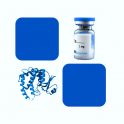
- Remove this product from my favorite's list.
- Add this product to my list of favorites.
Products
Newsletter
 |  |  |  |  |  |

Background
Inter-Cellular Adhesion Molecule 1 (ICAM-1) is also known as Cluster of Differentiation 54 (CD54), is a member of the immunoglobulin superfamily, and is a cell surface glycoprotein which is typically expressed in low concentrations on endothelial cells and cells of the immune system. The protein encoded by this gene is a type of intercellular adhesion molecule continuously present in low concentrations in the membranes of leukocytes and endothelial cells. Upon cytokine stimulation, the concentrations greatly increase. ICAM-1 can be induced by interleukin-1 (IL-1) and tumor necrosis factor alpha (TNFα) and is expressed by the vascular endothelium, macrophages, and lymphocytes. ICAM-1 is a ligand for LFA-1 (integrin), a receptor found on leukocytes. When activated, leukocytes bind to endothelial cells via ICAM-1/LFA-1 and then transmigrate into tissues. ICAM-1 has been implicated in subarachnoid hemorrhage (SAH). Levels of ICAM-1 are shown to be significantly elevated in patients with SAH over control subjects in many studies. ICAM-1 expressed by respiratory epithelial cells is also the binding site for rhinovirus, the causative agent of most common colds.
Source
Recombinant Human ICAM-1, Fc Tag (IC1-H5250) is expressed from human 293 cells (HEK293). It contains AA Gln 28 - Glu 480 (Accession # AAH15969).
Predicted N-terminus: Gln 28
Molecular Characterization
This protein carries a human IgG1 Fc tag at the C-terminus.
The protein has a calculated MW of 75.7 kDa. The protein migrates as 90-120 kDa under reducing (R) condition (SDS-PAGE) due to glycosylation.
Endotoxin
Less than 1.0 EU per μg by the LAL method.
Purity
>95% as determined by SDS-PAGE.
Formulation
Lyophilized from 0.22 μm filtered solution in 51 mM Tris, 100 mM Glycine, 150 mM NaCl, pH7.5 with trehalose as protectant.
Reconstitution
See Certificate of Analysis for details of reconstitution instruction and specific concentration.
Storage
For long term storage, the product should be stored at lyophilized state at -20°C or lower.
Please avoid repeated freeze-thaw cycles.
This product is stable after storage at:
-20°C to -70°C for 12 months in lyophilized state;
-70°C for 3 months under sterile conditions after reconstitution.
Bioactivity
Please refer to product data sheet.
(1) "Macrophage AHR-TLR4 cross-talk drives p-STAT3 (Ser727)-mediated mitochondrial oxidative stress and upregulates IDO/ICAM-1 in the steatohepatitis induced by aflatoxin B1"
Zhang, Liu, Shen et al
Sci Total Environ (2024) 923, 171377
(2) "Targeting aberrant glycosylation to modulate microglial response and improve cognition in models of Alzheimer's disease"
Wang, Du, Huang et al
Pharmacol Res (2024)
(3) "Andrographolide Improves ApoE4-Mediated Blood-Brain Barrier Injury by Alleviating Inflammation"
Zhou, Li, Quan et al
Mol Neurobiol (2024)
Showing 1-3 of 30910 papers.
Follow us